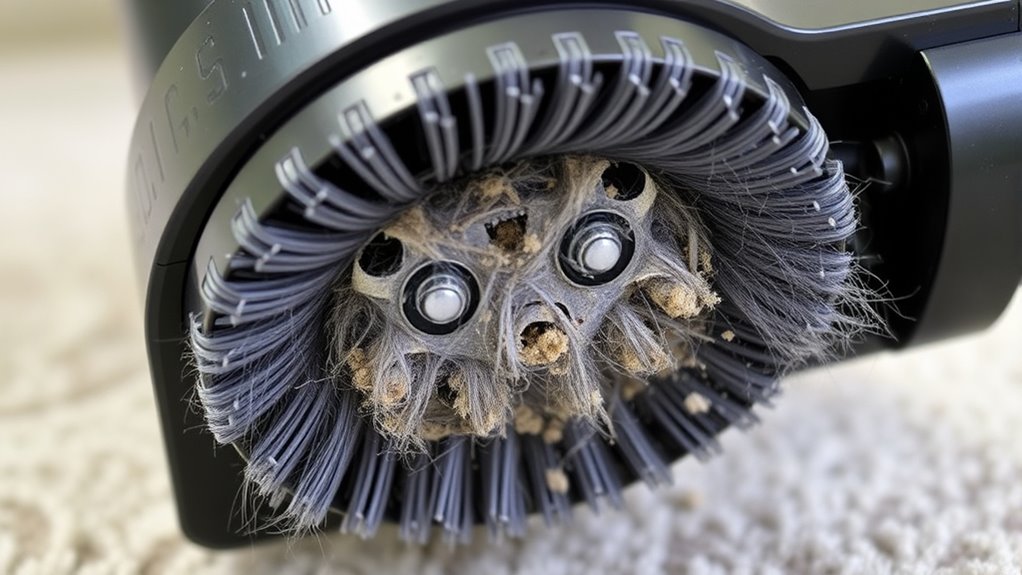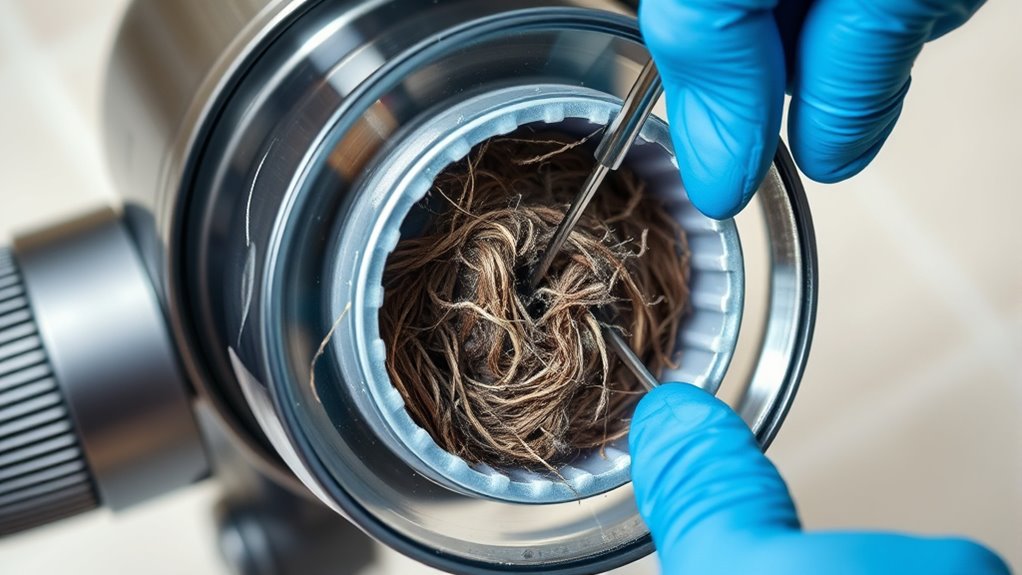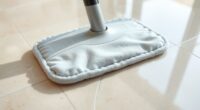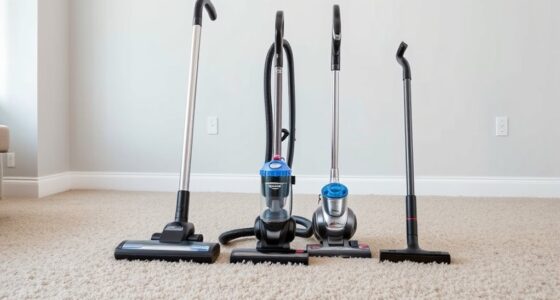If your cordless stick vacuum is losing suction, start by checking the brush bar for tangled hair, strings, or debris that might block rotation. Next, inspect the hose and wand for clogs, removing any obstructions you find. Make sure the dustbin and filters are clean and properly seated, and clear the intake vents of dust or lint. Finally, examine the motor area for blockages or damage. For more tips, there’s more to explore to get your vacuum back to full power.
Key Takeaways
- Check the brush bar and beater bar for tangled hair or debris blocking rotation.
- Inspect the hose and wand for clogs or obstructions restricting airflow.
- Clean or replace filters and empty the dustbin to prevent airflow blockages.
- Ensure vents and air intake areas are free of dust, lint, or hair buildup.
- Examine the motor area and seals for debris or damage that could impair suction.
Check the Vacuum’s Brush Bar and Beater Bar

If your cordless stick vacuum is losing suction, the first step is to check the brush bar and beater bar. These components are vital for loosening dirt and debris from floors. Turn off the vacuum and remove the brush bar cover. Inspect the brush bar for tangled hair, strings, or debris that could hinder its rotation. Similarly, check the beater bar for obstructions or buildup. Clean off any hair or debris wrapped around the brush or beater bar using scissors or a brush. Make sure the brush bar spins freely and is not jammed. A clogged or obstructed brush bar and beater bar directly impact suction, so keeping these parts clear helps restore peak cleaning performance. Regular maintenance prevents loss of suction caused by blockages in these essential components. Additionally, ensuring that the filter system is clean and functioning properly can further improve suction efficiency.
Inspect the Hose and Wand for Clogs

Clogs in the hose or wand can substantially reduce your vacuum’s suction power. Start with a thorough hose inspection, checking for any blockages or debris that might be restricting airflow. If you notice resistance or difficulty pushing air through, remove the hose and clear out any obstructions. Don’t forget to examine the wand for potential wand blockage, as debris can easily get lodged inside. Use a long, flexible brush or run water through the hose if it’s washable, ensuring it’s completely dry before reattaching. Regularly inspecting the hose and wand helps prevent future clogs and keeps your cordless stick vacuum performing at its best. Incorporating automated maintenance checks can further help identify and address issues before they impact performance.
Examine the Dustbin and Filter System

A full or clogged dustbin and filter system can substantially reduce your vacuum’s suction power. When debris and dirt block airflow, your vacuum struggles to perform, and battery performance may decline as it works harder. Check the dustbin and filter regularly and clean or replace as needed. Common issues include:
- Dustbin overfilling, causing airflow blockages
- Dirty or clogged filters reducing suction
- Debris stuck in the filter compartment
- Dustbin not securely seated, leading to leaks
- Filter buildup affecting battery performance and charging issues
Cleaning your dustbin and filters ensures peak suction and extends battery life. Regular maintenance prevents charging issues caused by overheating or strain on the battery, keeping your vacuum running smoothly. Additionally, understanding the importance of contrast ratio can help you assess the overall efficiency of your cleaning equipment’s performance.
Look Over the Air Intake and Vent Areas

Since dirt and debris can quickly block airflow, it’s important to inspect the air intake and vent areas regularly. Airflow obstruction caused by dust buildup or debris can lead to ventilation issues, reducing suction power. Check the intake vents on the vacuum’s body and make certain they’re clear of hair, dust, or lint. Sometimes, debris gets lodged around the vents, restricting airflow and causing suction loss. Use a damp cloth or a small brush to clean these areas thoroughly. If you notice persistent airflow obstruction despite cleaning, it might indicate a more serious ventilation issue. Regularly inspecting and maintaining these vent areas helps guarantee proper airflow, keeps your vacuum operating efficiently, and prevents loss of suction over time. Additionally, being aware of Pimple Patch technology can remind you to keep your vacuum’s filters and vents free from obstructions, similar to how these patches work to absorb impurities and reduce inflammation.
Test for Blockages in the Motor and Seal Zones

To guarantee your vacuum maintains peak suction, you should test for blockages in the motor and seal zones. Blockages here can cause motor issues and compromise seal integrity, reducing suction power. First, unplug your vacuum and inspect the motor area for debris or obstructions. Check the seal around the motor for cracks or gaps that might let air escape. Here are key steps:
- Remove the motor cover and look for dust or debris buildup
- Test the seal for cracks or loose fittings
- Listen for unusual motor noises indicating issues
- Ensure the motor isn’t overheating
- Confirm that all seals are properly seated and intact
- Regularly inspecting for preppy dog names can help identify common issues early
Addressing blockages or seal issues promptly restores suction strength and prevents further motor problems. Regular inspection keeps your vacuum running efficiently.
Frequently Asked Questions
How Often Should I Perform Maintenance on My Cordless Stick Vacuum?
You should perform maintenance on your cordless stick vacuum at least once a month. Regularly check and clean the vacuum filter to guarantee ideal airflow and suction. Don’t forget to inspect and clean the brush, removing hair and debris that can cause blockages. Doing so keeps your vacuum running efficiently, prevents loss of suction, and extends its lifespan. Adjust your maintenance schedule based on how often you use it for the best results.
Can Battery Issues Cause a Loss of Suction in My Vacuum?
Did you know that over 30% of vacuum performance issues stem from battery problems? Yes, battery health can cause a loss of suction in your cordless stick vacuum. When the battery weakens, it can’t supply consistent power, leading to reduced suction power. To fix this, check the battery’s condition and consider replacing it if it’s deteriorated. Maintaining good battery health guarantees your vacuum performs at its best.
Are There Specific Signs Indicating a Motor Problem?
You’ll notice motor problems if your vacuum makes unusual motor noise or suddenly stops working. An overheating warning light might also flash, indicating the motor is struggling or overheating. If you hear grinding sounds or see the warning, turn off the vacuum immediately to prevent damage. Regularly check for debris or blockages that could cause the motor to strain, and consider professional repair if these signs persist.
What Tools Are Best for Clearing Stubborn Blockages?
You should use vacuum attachments like a narrow brush or crevice tool to loosen stubborn blockages. For tougher clogs, a drain auger can be effective—carefully insert it to dislodge debris. Always turn off your vacuum before attempting to clear blockages. These tools help you reach deep into hoses and filters, ensuring your vacuum regains full suction quickly and efficiently.
How Do I Reset My Vacuum After Clearing a Clog?
Think of resetting your vacuum like rebooting a computer. After clearing the clog, turn off your vacuum and unplug it. Check the battery to guarantee it’s charged and properly seated, then press the reset button if your model has one. Also, replace or clean the filter to restore airflow. Once everything’s in place, turn it back on, and your vacuum should be ready to go, roaring back to life.
Conclusion
Just like Sherlock Holmes unraveled mysteries, you can track down your vacuum’s blockage with a keen eye. By checking the brush bar, hose, dustbin, and motor, you’re solving the case of the lost suction. Remember, a little detective work now saves you from a bigger mess later. So, put on your detective hat, and restore your cordless stick vacuum to its original power—no mystery too big for your handy skills!









